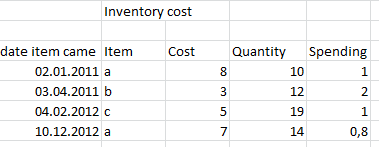Unlock a world of possibilities! Login now and discover the exclusive benefits awaiting you.
- Qlik Community
- :
- All Forums
- :
- QlikView App Dev
- :
- Empty fields in table
- Subscribe to RSS Feed
- Mark Topic as New
- Mark Topic as Read
- Float this Topic for Current User
- Bookmark
- Subscribe
- Mute
- Printer Friendly Page
- Mark as New
- Bookmark
- Subscribe
- Mute
- Subscribe to RSS Feed
- Permalink
- Report Inappropriate Content
Empty fields in table
Hello,
I have a table called "Inventory cost" (pic 1)

Another table called "remained in stock" (pic 2)

So, I have to make final table

, where:
quantity in the begining calculated like
RangeSum(
Sum({$< InOrOut = {0}, DateMovement = {'<=$(vMinSelectedDate)'}, Date >} Quantity),
Sum({$< InOrOut = {1}, DateMovement = {'<=$(vMinSelectedDate)'}, Date >} Quantity*(-1))
)
Fields Quantity in, out and in the end calculated similarly.
Field "avg cost":
avg( aggr(sum(DISTINCT(cost +quantity)),Date, Item, DateItemCame))
The problem is that some fields in column avg cost is missed. Everything else calculated excellent.
Please help!
I'm new in qlikview. And sorry for my english)
- Tags:
- qlikview_scripting
- « Previous Replies
-
- 1
- 2
- Next Replies »
- Mark as New
- Bookmark
- Subscribe
- Mute
- Subscribe to RSS Feed
- Permalink
- Report Inappropriate Content
Hi,
how the two tables are joined?
I see both item and quantity in the two tables.
I suppose you are working with the data of the secont table and using field from the first is not working fine.
- Mark as New
- Bookmark
- Subscribe
- Mute
- Subscribe to RSS Feed
- Permalink
- Report Inappropriate Content
Hi
I think your expression for average cost should look something like:
avg(aggr(sum(Quantity / Cost), Item, DateItemCame))
Regards
Jonathan
- Mark as New
- Bookmark
- Subscribe
- Mute
- Subscribe to RSS Feed
- Permalink
- Report Inappropriate Content
Two tables connected by the field - Item.
Quantity columns are differs. I'm sorry for not clear question.
You are right, I use 2nd table and use fields from 1st to calculate the average cost
- Mark as New
- Bookmark
- Subscribe
- Mute
- Subscribe to RSS Feed
- Permalink
- Report Inappropriate Content
I've tried to use it. But the result was the same.
I think the problem is with Date.
For example, if I not using Date in columns "Quantity on the beginning" and etc the Average column shows everything perfect. But not using Date, the quantity calculates incorrectly.
- Mark as New
- Bookmark
- Subscribe
- Mute
- Subscribe to RSS Feed
- Permalink
- Report Inappropriate Content
How would you like the movement date to relate to the cost date?
- Mark as New
- Bookmark
- Subscribe
- Mute
- Subscribe to RSS Feed
- Permalink
- Report Inappropriate Content
Thank you, Jonathan, for reply.
Actually they are not related. I don't want to relate them. Two tables joined only by "Item". What I want is to take 2nd table as base and take some columns from 1st to calculate the average cost
- Mark as New
- Bookmark
- Subscribe
- Mute
- Subscribe to RSS Feed
- Permalink
- Report Inappropriate Content
I made a mistake in posting, of course I use spending instead of quantity)..
So I calculate avg cost like:
=avg( aggr(sum(DISTINCT(cost +spending)),Date, Item, DateItemCame)).. Works fine, but misses some Items. Why???.. I don't understand(
- Mark as New
- Bookmark
- Subscribe
- Mute
- Subscribe to RSS Feed
- Permalink
- Report Inappropriate Content
Well, if the quantity, cost and item all come the first table, and the item field has the same name as in the second table, and if it is only key between the two tables, then I see no reason that expression does not work. You might need to post a more detailed example, with the correct field names, so that I can better understand your data structure.
Jonathan
- Mark as New
- Bookmark
- Subscribe
- Mute
- Subscribe to RSS Feed
- Permalink
- Report Inappropriate Content
Iskander Smagulov wrote:
So I calculate avg cost like:
=avg( aggr(sum(DISTINCT(cost +spending)),Date, Item, DateItemCame)).. Works fine, but misses some Items. Why???.. I don't understand(
I dont understand what you are trying to calculate with that expression. Using distinct will only consider one cost+spending amount, even if there are several for different items. Perhaps you mean
avg(aggr(DISTINCT Sum(...
Also, if either cost or spending is null or is missing, then cost+spending will evaluate to null. So use RangeSum(cost , spending) in place of cost+spending.
I hope that helps
Jonathan
- « Previous Replies
-
- 1
- 2
- Next Replies »